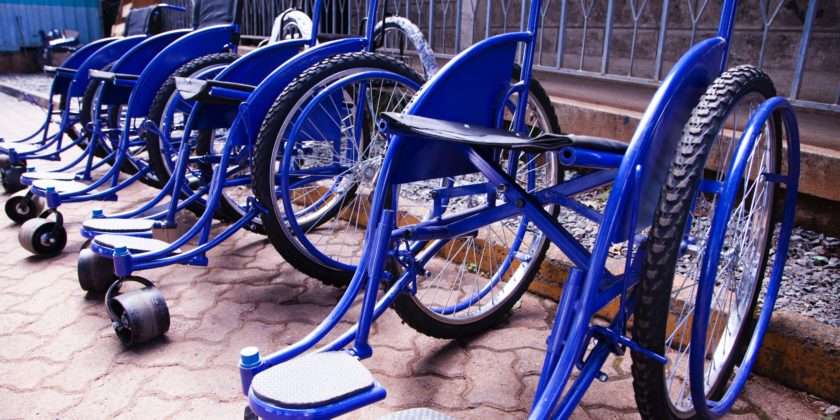About 56.7 million people — 19 percent of the population — had a disability in 2010, according to a broad definition of disability, with more than half of them reporting the disability was severe, according to a comprehensive report on this population released today by the U.S. Census Bureau. Jay Harold wrote this post, “,9 Conditions, Situations, & Disability Benefits of Social Security” to give you more information about this complex and vital issue affecting you or someone you know.
The Social Security and Supplemental Security Income disability programs1 are the largest of several Federal programs that provide assistance to people with disabilities. While these two programs are different in many ways, both are administered by the Social Security Administration, and only individuals who have a disability and meet medical criteria may qualify for benefits under either program.
Social Security Disability Insurance pays benefits to you and certain members of your family if you are “insured,” meaning that you worked long enough and paid Social Security taxes.
Supplemental Security Income pays benefits based on financial need.
When you apply for either program, we will collect medical and other information from you and make a decision about whether or not you meet Social Security’s definition of disability (See below).
Use the Benefits Eligibility Screening Tool2 to find out which programs may be able to pay you benefits.
If your application has recently been denied, the Internet Appeal3 is a starting point to request a review of our decision about your eligibility for disability benefits.
If your application is denied for:
- Medical reasons, you can complete and submit the required Appeal Request and Appeal Disability Report online. The disability report asks you for updated information about your medical condition and any treatment, tests or doctor visits since we made our decision.
- Non-medical reasons, you should contact your local Social Security Office to request the review. You also may call our toll-free number, 1-800-772-1213, to request an appeal. People who are deaf or hard of hearing can call our toll-free TTY number, 1-800-325-0778.

How Do You qualify for Disability4 ?
To qualify for Social Security disability benefits, you must first have worked in jobs covered by Social Security. Then you must have a medical condition that meets Social Security’s definition of disability. In general, we pay monthly benefits to people who are unable to work for a year or more because of a disability.
Benefits usually continue until you can work again on a regular basis. There are also a number of special rules, called “work incentives,” that provide continued benefits and health care coverage to help you make the transition back to work.
If you are receiving Social Security disability benefits when you reach full retirement age5 , your disability benefits automatically convert to retirement benefits, but the amount remains the same.
How Much Work Do You Need?
In addition to meeting our definition of disability, you must have worked long enough — and recently enough — under Social Security to qualify for disability benefits.
Social Security work credits are based on your total yearly wages or self-employment income. You can earn up to four credits each year.
The amount needed for a work credit changes from year to year. In 2018, for example, you earn one credit for each $1,320 in wages or self-employment income. When you’ve earned $5,280, you’ve earned your four credits for the year.
The number of work credits you need to qualify for disability benefits depends on your age when you become disabled. Generally, you need 40 credits, 20 of which were earned in the last 10 years ending with the year you become disabled. However, younger workers may qualify with fewer credits6 .
What We Mean By Disability
The definition of disability under Social Security is different than other programs. Social Security pays only for total disability. No benefits are payable for partial disability or for short-term disability.
We consider you disabled under Social Security rules if:
- You cannot do work that you did before;
- We decide that you cannot adjust to other work because of your medical condition(s); and
- Your disability has lasted or is expected to last for at least one year or to result in death.
This is a strict definition of disability. Social Security program rules assume that working families have access to other resources to provide support during periods of short-term disabilities, including workers’ compensation, insurance, savings, and investments.

How We Decide If You Are Disabled
If you have enough work to qualify for disability benefits, we use a step-by-step process involving five questions. They are:
1. Are you working?
If you are working in 2018 and your earnings average more than $1,180 a month, you generally cannot be considered disabled.
If you are not working, we will send your application to the Disability Determination Services7 (DDS) office that will make the decision about your medical condition. The DDS uses Steps 2-5 below to make the decision.
2. Is your condition “severe”?
Your condition must significantly limit your ability to do basic work such as lifting, standing, walking, sitting, and remembering – for at least 12 months. If it does not, we will find that you are not disabled.
If your condition does interfere with basic work-related activities, we go to Step 3.
3. Is your condition found in the list of disabling conditions?
For each of the major body systems, we maintain a list of medical conditions that we consider so severe that it prevents a person from completing substantial gainful activity. If your condition is not on the list, we have to decide if it is as severe as a medical condition that is on the list. If it is, we will find that you are disabled. If it is not, we then go to Step 4.
We have two initiatives designed to expedite our processing of new disability claims:
- Compassionate Allowances: Certain cases that usually qualify for disability can be allowed as soon as the diagnosis is confirmed. Examples include acute leukemia, Lou Gehrig’s disease (ALS), and pancreatic cancer.
- Quick Disability Determinations: We use sophisticated computer screening to identify cases with a high probability of allowance.
For more information about our disability claims process, visit our Benefits For People With Disabilities website.
4. Can you do the work you did previously?
At this step, we decide if your medical impairment(s) prevents you from performing any of your past work. It is doesn’t; we’ll decide you don’t have a qualifying disability. If it does, we proceed to Step 5.
5. Can you do any other type of work?
If you can’t do the work you did in the past, we look to see if there is other work you could do despite your impairment(s).
We consider your medical conditions and your age, education, past work experience, and any transferable skills you may have. If you can’t do other work, we’ll decide you are disabled. If you can do other work, we’ll decide that you don’t have a qualifying disabled and your claim will be denied.

Special Situations
Most people who receive disability benefits are workers who qualify on their own records and meet the work and disability requirements we have just described. However, there are some situations you may not know about:
Special Rules For People Who Are Blind Or Have Low Vision
We consider you to be legally blind under Social Security rules if your vision cannot be corrected to better than 20/200 in your better eye or if your visual field is 20 degrees or less, even with a corrective lens. Many people who meet the legal definition of blindness still have some sight and may be able to read large print and get around without a cane or a guide dog.
If you do not meet the legal definition of blindness, you may still qualify for disability benefits if your vision problems alone or combined with other health problems prevent you from working.
There are a number of special rules for people who are blind that recognize the severe impact of blindness on a person’s ability to work. For example, the monthly earnings limit for people who are blind is generally higher than the limit that applies to non-blind disabled workers.
In 2018, the monthly earnings limit is $1,970.
Benefits For Disabled Widows Or Widowers
If something happens to a worker, benefits may be payable to their widow, widower, or surviving divorced spouse with a disability if the following conditions are met:
- He or she is between ages 50 and 60;
- Their condition meets the definition of disability for adults; and
- The disability started before or within seven years of the worker’s death.
Widows, widowers, and surviving divorced spouses cannot apply online for survivors benefits. However, if they want to apply for benefits, they should contact Social Security immediately at 1-800-772-1213 to request an appointment. (If they are deaf or hard of hearing, they should call our TTY number at 1-800-325-0778.)
If they are disabled, they can speed up the application process if they complete an Adult Disability Report8 and have it available at the time of their appointment.
We use the same definition of disability for widows and widowers as we do for workers.
Benefits For A Disabled Child
A child under age 18 may be disabled, but we don’t need to consider the child’s disability when deciding if he or she qualifies for benefits as your dependent. The child’s benefits normally stop at age 18 unless he or she is a full-time student in an elementary or high school (benefits can continue until age 19) or is disabled.

Adults Disabled Before Age 22
An adult disabled before age 22 may be eligible for child’s benefits if a parent is deceased or starts receiving retirement or disability benefits. We consider this a “child’s” benefit because it is paid on a parent’s Social Security earnings record.
The “adult child”—including an adopted child, or, in some cases, a stepchild, grandchild, or stepgrandchild—must be unmarried, age 18 or older, have a disability that started before age 22, and meets the definition of disability for adults.
It is not necessary that the adult child ever worked. Benefits are paid based on the parent’s earnings record.
- An adult child must not have substantial earnings. The amount of earnings we consider “substantial” increases each year. In 2018, this means working and earning more than $1,180 a month.
What if the adult child is already receiving SSI benefits or disability benefits on his or her own record?
An adult child already receiving SSI benefits or disability benefits on his or her own record should still check to see if benefits may be payable on a parent’s earnings record. Higher benefits might be payable, and entitlement to Medicare may be possible.

How do we decide if an adult “child” is disabled for SSDI benefits?
If a child is age 18 or older, we will evaluate his or her disability in the same way we would evaluate the disability for any adult. We send the application to the Disability Determination Services in your state that completes the disability decision for us.
What happens if the adult child gets married?
If he or she receives benefits as an adult disabled since childhood, the benefits generally end if he or she gets married. However, some marriages (for example, to another adult disabled child) are considered protected.
The rules vary depending on the situation. Contact a Social Security representative at 1-800-772-1213 (If you are deaf or hard of hearing, call TTY number at 1-800-325-0778) to find out if the benefits can continue.
You can speed up the application process if you complete an Adult Disability Report and have it available at the time of your appointment.
Jay Harold hopes that you enjoyed this post, “9 Conditions, Situations, & Disability Benefits of Social Security.” Please share it with others. Jay Harold has put together a Resource page that you may find useful when trying to improve your health and wealth. Please take this advice from Muhammad Ali and give back to others. “Service to others is the rent you pay for your room here on earth.”
Bibliography
- https://www.ssa.gov/disability/
- https://ssabest.benefits.gov/
- https://secure.ssa.gov/iApplsRe/start
- https://www.ssa.gov/planners/disability/qualify.html
- https://www.ssa.gov/planners/retire/retirechart.html
- https://www.ssa.gov/planners/credits.html
- https://www.ssa.gov/planners/disability/df-dds.html
- https://www.ssa.gov/forms/ssa-3368.pdf




